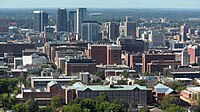
Photo from wikipedia
Air pollution is responsible for a wide range of health effects in exposed populations. Variations in local air pollution can affect local population health outcomes. The strict regulations imposed during… Click to show full abstract
Air pollution is responsible for a wide range of health effects in exposed populations. Variations in local air pollution can affect local population health outcomes. The strict regulations imposed during the peak of the COVID-19 pandemic (‘lockdowns’) resulted in a unique situation where human mobility was limited significantly, resulting in improved air quality in several major cities. The main goal of this study was to investigate if lockdowns during the COVID-19 pandemic significantly impacted air quality in Birmingham, Alabama—a city with a history of high air pollution levels—with a focus on PM2.5 (Particulate Matter with an aerodynamic diameter ≤2.5 µm) and NO2 (Nitrogen dioxide). Daily air pollutant and traffic data were obtained for the Birmingham Metropolitan Area for the period January to October 2020, and previous years. Mean PM2.5 and NO2 concentrations and traffic volumes during the official city/state lockdown period (24 March to 30 April 2020) were compared to pre- and post-lockdown means. The mean PM2.5 and NO2 concentrations during the lockdown did not significantly differ from that of the pre- or post-lockdown periods. However, NO2 significantly decreased even after the lockdown order was removed, with the mean decreasing significantly compared to pre-lockdown and lockdown periods. Both PM2.5 and NO2 annual means in 2020 were significantly lower than the annual means in 2019, indicating the occurrence of significant changes over the longer term that were not limited by defined lockdown periods. Traffic significantly increased after the lockdown order was removed but did not correlate with the two pollutants studied. Therefore, we conclude that the Stay at Home/lockdown regulations and other COVID-19 restrictions had an impact on the air quality of Birmingham Alabama; although these lockdown impacts varied for each pollutant and were not limited only by the official lockdown dates/periods.
Journal Title: International Journal of Environmental Research and Public Health
Year Published: 2022
Link to full text (if available)
Share on Social Media: Sign Up to like & get
recommendations!